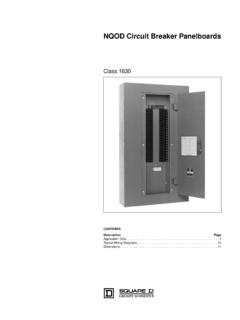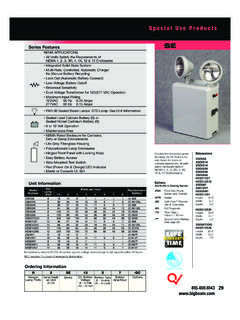Transcription of Enclosure Design Considerations - Saginaw Control
1 Enclosure Design ConsiderationsSaginaw Control & Engineering s enclosures are designed, manufactured, and tested to meet the requirements for Enclosure Types 1, 3, 3R, 3S, 4, 4X, 12, 13 and IP ratings up to IP66. An Enclosure that is selected to meet a specific rating and standard may not meet all requirements of your application and environment without additional steps that may be necessary to adequately protect your product in your application and evaluate your Enclosure selection for each of the following listed below in your end use application. Remember this statement, each of the Enclosure Rating descriptions Provide a degree of protection . See the Enclosure Type Ratings document on our website for more Rain, Snow, and IceA common misconception is that a Type 4, 4X Enclosure can be used in any indoor or outdoor application, regardless of its environment, exposure, or installation, and will remain water tight.
2 This is not true. Additional steps may be necessary to properly protect your product in its environment. (Not Water Proof)What does the Type 4 & 4X test involve?Protection against the ingress of water - hose down test. The Enclosure and its external mechanisms are subjected to a stream of water from a hose that has a 25 mm (1 in) inside diameter nozzle that delivers at least 240 L (65 gal) per minute. The nozzle is held from to m (10 to 12 ft) from the Enclosure , and the spray of water is directed at all points of potential water entry, such as seams, joints, external operating mechanisms, and the like. The nozzle is moved along each test point one at a time in a uniform nominal rate of 6 mm/sec ( in/sec). A conduit is installed to equalize internal and external pressures. At the end of the test no water has entered the Enclosure . See UL 50E and CSA for complete ApplicationsFor all enclosures in outdoor applications with direct exposure to rain, snow, and ice, a drip shield is always recommended, and in most applications it is required.
3 Drip shields minimize risk related to long term exposure to rain and damaging effects of snow and ice being trapped in the external cavity of the door and Enclosure body and prolonged exposure to water that may lead to water being absorbed into the VentilationAn Enclosure that is not adequately vented and in an outdoor or wash down environment may lead to leakage due to drastic temperature changes caused by rainfall or hose down with cold or hot Enclosure that is subjected to a temperature differential of just 20 to 30 degrees, for instance one with an internal temperature of about 85 F which has hose directed water applied with city water (average temperature of 55 F), can result in damage to the seal. When the water is applied, the temperature inside the Enclosure rapidly drops, the air contracts and creates a vacuum inside the Enclosure that starts to draw water through at the weakest link, or even pull water through the gasket, almost immediately and until the pressure is equalized.
4 The smaller the Enclosure or part the quicker this reaction occurs. An Enclosure in an outdoor application will be exposed to conditions that are far more severe taking in to consideration the solar gain and the internal temperature rise of the Enclosure and rain temperatures that can be as low as 32 some installations of enclosures, a wire conduit may be found to be adequate to serve as its vent and equalize the pressure, but in most applications is not enough. In Type 4 and 4X Enclosures, no drain holes are required or provided, so it is increasingly important that sufficient ventilation exists or Type 4, 4X breathers or Type 4, 4X drain/breathers are added to equalize 3R RainproofA Type 3R Rainproof Enclosure is provided with drip shield and drainage holes that also serve as ventilation to equalize pressure as required. A multi-listed Enclosure such as an Enclosure listed as Type 3R, 4 & 12 is provided with additional instructions for installation of a drip shield and drainage does the Type 3R Rain test involve?
5 Enclosures with a conduit connected shall be mounted as in actual service, the test apparatus consists of at least three spray heads mounted in a water supply pipe rack. The Enclosure is positioned in the focal area of the spray heads so that the greatest quantity of water is likely to enter the Enclosure . The water pressure is maintained at (5 psi) at each spray head and a continuous water spray shall be applied for one hour. Type 3R Enclosure is considered to have met the requirements if at the conclusion of the test a) There is no accumulation of water withinthe Enclosure ; and b) No water has entered the Enclosure at a level higher than the lowest live ! Saginaw Control & Engineering recommends the use of drip shield, ventilation and drainage when installed in full outdoor exposure and extreme weather environments. Saginaw Control & Engineering does not recommend the use of polycarbonate viewing windows for use as type 4 or 4X when installed in full outdoor exposure and extreme weather environments.
6 Recommend Type 3R rating for this application. Carefully considered and evaluate your end use environment for the reasons described Corrosion - Exposure to Salt Water or Other ChemicalsEvaluate the environment of the end use location and the chemicals that the Enclosure may be exposed Protection RequirementsThe corrosion protection requirements for a Type 1, 12, 3R, 4 and 4X are very specifically targeted and an Enclosure may be manufactured out of a combination of materials that meet the corrosion requirements for the Enclosure type, although may not be adequate for your application without making does the Type 4X Corrosion test involve?Indoor Type 1 & 12 - 24-hour salt spray. The test apparatus shall consist of a fog chamber, a salt-solution reservoir, a supply of compressed air, atomizing nozzles, support for the Enclosure , provision for heating the chamber, and means of Control .
7 Type 3R, 4, 4X. 1200-hour moist carbon dioxide-sulfur dioxide-air, 600-hour salt spray. (Two un-scribed specimens and two specimens scribed) Outdoor Type 3RX, 4X. 1200-hour moist carbon dioxide-sulfur dioxide-air, 600-hour salt spray (Two un-scribed specimens and two specimens scribed) and an additional 200-hour salt spray. See UL 50E and CSA for complete primary targets of the corrosion test requirements are with respect to water, salt water, and basic air pollutants. Salt water should be considered when applications are near coastlines and roadways, effects of salt air can be a concern from 5 miles to 25 mile inland depending on the region. The effects of salt water can be extreme even with type 304 stainless steel although the effects are more cosmetic than structural or functional. If cosmetics are critical, then type 316 stainless steel may be a better choice, yet it is not impervious to rust and staining caused by airborne debris and chemicals that may end up on the material chemicals, such as acids, solvents, fluoride, chloride, cleaning detergents and hundreds of other chemicals in a multitude of different concentrations, can severely effect even the most resilient materials, for instance type 316 stainless steel, and are not considered part of their corrosion performance CompatibilityGalvanic corrosion (sometimes called dissimilar metal corrosion) is the process by which materials in contact with one another oxidize or corrode, accelerating the deterioration of one of the metals.
8 In some instances, galvanic corrosion can even be helpful in some applications. For example, if pieces of zinc or copper are attached to the bottom of a steel water tank, the zinc or copper will become the anode, and it will corrode. The steel in the tank becomes the cathode, and it will not be affected by the corrosion. This technique is known as cathodic protection. The metal to be protected is forced to become a cathode, and it will corrode at a much slower rate than the other metal, which is used as a sacrificial ! Saginaw Control & Engineering recommends the application and environment is carefully considered and evaluated for the reasons described above. There may be chemicals, acids, solvents, or gasses outside the scope of the corrosion resistant requirements in your application or environment that will adversely affect the performance of the Enclosure or materials used in its Thermal Conditions & ManagementEvaluate environment of end use location and its exposure to ambient heat, internal heat, and solar temperature, both outside the Enclosure and inside the Enclosure , must be carefully considered for the application, regardless of the Enclosure type.
9 Excessive heat or cold can seriously compromise both the performance and functionality of Enclosure in its end environment as well as the equipment it temperatures can an Enclosure sustain?Plastics, windows, gaskets, and coatings are tested for their performance (Resistance Hot and Cold). Cooled to a temperature of minus 30 C (minus 22 F) for a period of 24 hours and then subjected to an impact and crush resistant test. Heat - Max. temperature for outdoor application 60 C/140 F test in circulating air for 168 hours have a tensile strength of not less than 75 percent and an elongation of not less than 60 percent of values determined for unaged samples. At the conclusion of the tests, there is no visible deterioration, deformation, melting, or cracking of the material. See UL 50E and CSA for complete Heat LoadInternal heat produced by the electronic components can considerably increase the internal temperature (Heat Rise).
10 Just 1 watt added to 1 cubic foot of space can increase the internal temperature by as much as 3 F. Different base materials have different thermal conductivity (K Value), stainless, aluminum, fiberglass, and steel, as well as their finish, greatly influence internal heat dissipation and heat rise, so they must be considered when determining the proper thermal management options for the application. Choosing the incorrect thermal management option can compromise the performance, components, electronics and environmental rating of your Gain, High Ambient ConditionsSolar Gain refers to the increase in temperature in a space that results from solar radiation. The amount of solar gain increases with the strength of the sun. Shading, reflection, and color can be used to minimize the effects and cooling Enclosure in a location with full exposure to the sun and 0 watts of internal heat load can reach temperatures that exceed 160 F degrees and exceed the performance limitation of test requirements and performance limitation of some materials, such as polycarbonate a result of the Internal heat load, higher temperatures, solar gain or the combination of some or all of these conditions, cooling systems, such as Air Conditioners, Heat Exchangers or Chillers are often required in many applications whether the Enclosure is indoors or outdoors, insulated or Ambient ConditionsHeat may be required to raise the temperature of the Control panel, for freeze protection, reduce humidity, prevent damage to the electronic components or improve efficiency of electronics.







